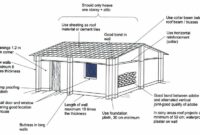Flood Resistant Houses – Flooding is one of the most devastating natural disasters, causing significant loss of life and property.
With climate change leading to more intense weather patterns, the need for effective flood-resistant housing has never been more critical.
This article provides an in-depth analysis of flood-resistant houses, exploring their design principles, construction materials, technologies, and the cause-and-effect relationships that highlight their importance in mitigating flood risks.
1. Understanding Flood Risks
1.1 Types of Flooding
Flooding can occur due to several reasons, including:
- River Flooding: Caused by excessive rainfall leading to overflowing rivers.
- Flash Flooding: Rapid floods occurring due to heavy rain within a short period, often in mountainous areas.
- Coastal Flooding: Results from storm surges and rising sea levels.
- Urban Flooding: Occurs in cities due to poor drainage systems.
1.2 Causes of Flooding
Understanding the causes of flooding helps in designing flood-resistant houses. Some key factors include:
- Heavy Rainfall: Intense storms can overwhelm drainage systems.
- Melting Snow: Rapid thawing can lead to increased water levels in rivers and streams.
- Deforestation: Reduces natural water absorption, leading to higher runoff.
- Climate Change: Increases the frequency and severity of extreme weather events.
Read also:
1. Earthquake-Resistant House Design: A Comprehensive Guide to Building Safe and Sustainable Homes
2. Fire-Resistant Home Design: Essential Ideas for Fire Safety
3. Building a Hurricane-Resistant Home: Key Features and Considerations
2. Importance of Flood-Resistant Houses
2.1 Reducing Economic Losses
Flood-resistant houses minimize damage, reducing repair costs and financial burdens on homeowners. The cause-and-effect relationship here is clear: resilient homes lead to fewer insurance claims and economic stability.
2.2 Protecting Lives
Properly designed flood-resistant houses protect residents from the dangers of flooding. Elevated structures and reinforced materials can save lives during extreme weather events.
2.3 Environmental Benefits
Flood-resistant designs often incorporate sustainable practices, promoting better water management and reducing urban runoff. This relationship fosters healthier ecosystems and improves local biodiversity.
3. Design Principles for Flood-Resistant Houses
3.1 Elevation
Elevating homes above potential flood levels is a primary design principle. This can be achieved through:
- Piers or Piles: Structures built on elevated supports, allowing water to flow underneath.
- Fill: Using soil to raise the foundation level.
3.2 Sloped Landscapes
Constructing homes on sloped landscapes can direct water away from the foundation. This prevents water accumulation and reduces the risk of flooding.
3.3 Water-Resistant Materials
Using water-resistant materials is crucial. These include:
- Concrete: Durable and resistant to water damage.
- Steel: Provides structural strength and resistance to corrosion.
- Treated Wood: Can withstand moisture and resist rot.
4. Advanced Technologies in Flood Resistance
4.1 Flood Barriers
Installing flood barriers around properties can prevent water ingress. These barriers can be temporary or permanent and are designed based on the specific flood risk.
4.2 Smart Home Technologies
Integrating smart technologies helps monitor water levels and alerts homeowners to potential flooding. Automated systems can close vents and doors to prevent water entry.
4.3 Green Infrastructure
Implementing green roofs and permeable pavements can absorb rainwater, reducing runoff. This relationship enhances water management and decreases the likelihood of urban flooding.
5. Building Codes and Regulations
5.1 Understanding Local Codes
Adhering to local building codes is essential. Many regions prone to flooding have specific regulations that require flood-resistant designs. This ensures that homes meet safety standards and are built to withstand flooding.
5.2 Zoning Laws
Zoning laws can restrict construction in flood-prone areas. This proactive measure reduces the risk of damage and promotes safer community planning.
6. Community Planning and Flood Resistance
6.1 Collaborative Efforts
Communities must work together to develop flood-resistant strategies. This includes improving drainage systems, creating green spaces, and establishing emergency response plans.
6.2 Public Awareness
Educating residents about flood risks and prevention measures fosters a culture of preparedness. Knowledgeable homeowners can take proactive steps to protect their properties.
Conclusion
Flood-resistant houses are essential in mitigating the risks associated with flooding.
Through careful design, the use of appropriate materials, and the integration of advanced technologies, these homes protect lives and properties while promoting environmental sustainability.
The cause-and-effect relationships explored in this article highlight the critical role of flood-resistant housing in creating safer communities in an increasingly unpredictable climate.
Investing in flood resilience is not just a personal choice but a collective responsibility to safeguard our homes and neighborhoods against the threats posed by climate change.
Create a Cozy Boho Living Room: Alabama, Alaska, Arizona, Arkansas, California, Colorado, Connecticut, Delaware, Florida, Georgia, Hawaii, Idaho, Illinois, Indiana, Iowa, Kansas, Kentucky, Louisiana, Maine, Maryland, Massachusetts, Michigan, Minnesota, Mississippi, Missouri, Montana, Nebraska, Nevada, New Hampshire, New Jersey, New Mexico, New York, North Carolina, North Dakota, Ohio, Oklahoma, Oregon, Pennsylvania, Rhode Island, South Carolina, South Dakota, Tennessee, Texas, Utah, Vermont, Virginia, Washington, West Virginia, Wisconsin, Wyoming.
Buenos Aires, Argentina; São Paulo, Brazil; Rio de Janeiro, Brazil; Bogotá, Colombia; Lima, Peru; Santiago, Chile; Caracas, Venezuela; Montevideo, Uruguay; Quito, Ecuador; Asunción, Paraguay; La Paz, Bolivia; Sucre, Bolivia; Medellín, Colombia; Cali, Colombia; Guayaquil, Ecuador; Valparaíso, Chile; Rosario, Argentina; Córdoba, Argentina; Maracaibo, Venezuela; Barranquilla, Colombia; Manaus, Brazil.
Africa:
Cairo, Lagos, Nairobi, Dakar, Johannesburg, Casablanca, Addis Ababa, Accra, Tunis, Lusaka, Harare, Kampala, Algiers, Khartoum, Mogadishu, Freetown, Windhoek, Kigali, Bamako, Dar es Salaam.
Australia:
Sydney, Melbourne, Brisbane, Perth, Adelaide, Hobart, Darwin, Canberra, Gold Coast, Cairns, Newcastle, Wollongong, Geelong, Townsville, Launceston, Toowoomba, Ballarat, Bendigo, Albury, Rockhampton.
Europe:
London, Paris, Rome, Berlin, Madrid, Vienna, Amsterdam, Lisbon, Prague, Athens, Brussels, Copenhagen, Oslo, Dublin, Warsaw, Helsinki, Stockholm, Budapest, Edinburgh, Zurich, Munich.






